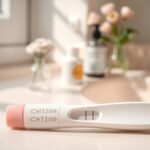Navigating the postpartum recovery journey can be challenging, but a simple yet effective solution lies in the comforting embrace of a sitz bath. These therapeutic soaks have long been recognized for their ability to promote healing and alleviate common discomforts associated with childbirth. As you embark on the path to postpartum recovery, understanding the benefits and proper use of sitz baths can be a game-changer in your healing process.
Sitz baths are a time-honored tradition that have been used for centuries to support the body’s natural healing mechanisms after childbirth. By immersing the pelvic region in warm, soothing water, these baths can help reduce inflammation, ease pain, and facilitate the recovery of the perineal area, which often experiences trauma during delivery.
Key Takeaways
- Sitz baths are a valuable tool for postpartum recovery, promoting healing and alleviating common discomforts.
- These therapeutic soaks have been used for centuries to support the body’s natural healing mechanisms after childbirth.
- Sitz baths can help reduce inflammation, ease pain, and facilitate the recovery of the perineal area.
- Proper use and incorporation of sitz baths into your postpartum routine can be a game-changer in your healing journey.
- Understanding the benefits and proper techniques for sitz baths can empower you to take an active role in your postpartum recovery.
Understanding What a Sitz Bath Is and Its Benefits
A sitz bath is a therapeutic soaking treatment that has been used for centuries to promote postpartum healing and perineal care. This time-honored practice involves sitting in a shallow tub of warm water, targeting the buttocks, hips, and lower back area. Sitz baths have gained renewed popularity as an effective and natural approach to supporting the body’s natural recovery process after childbirth.
Origins and Traditional Uses
The concept of the sitz bath has its roots in ancient medical traditions, with references dating back to ancient Greece and Rome. Throughout history, sitz baths have been employed to address a variety of women’s health issues, including postpartum recovery, hemorrhoid relief, and pelvic floor strengthening.
Basic Components of a Sitz Bath
- A shallow basin or tub designed to fit over a standard toilet
- Warm water, usually kept at a comfortable temperature between 95-105°F
- Optional therapeutic additives such as epsom salts, herbs, or essential oils
Scientific Benefits for Healing
Modern research has confirmed the numerous benefits of incorporating sitz baths into postpartum healing methods. Studies have shown that regular sitz baths can help to soothe discomfort, reduce swelling, and promote faster healing of the perineal care area after childbirth, whether from natural tears or episiotomy.
Additionally, the warm water and relaxing nature of a sitz bath can help to alleviate sitz bath definition issues such as hemorrhoids, providing much-needed relief during the postpartum recovery period.
Essential Supplies Needed for Your Postpartum Sitz Bath
As you embark on your postpartum healing journey, having the right sitz bath kit and postpartum recovery supplies can make all the difference. These carefully curated healing essentials will help you create a soothing, restorative experience during this delicate time.
Here’s a list of the must-have items to assemble your perfect postpartum sitz bath:
- Sitz bath tub or basin – Designed to fit comfortably over your toilet for easy, hands-free use.
- Warm water – Aim for a temperature between 98-102°F to promote healing.
- Epsom salts – Add a handful to the water to soothe and reduce inflammation.
- Witch hazel pads – These cooling pads can provide relief for hemorrhoids or episiotomy sites.
- Herbal sachets – Look for soothing herbs like chamomile, lavender, or calendula.
- Gentle, fragrance-free soap – Keep the area clean without irritating sensitive skin.
- Soft, clean towels – Have a few on hand to gently pat dry after your sitz bath.
With these sitz bath kit essentials at the ready, you’ll be well-equipped to perform this restorative postpartum ritual and support your body’s natural healing process.
Step-by-Step Guide to Preparing Your Sitz Bath
Eager to experience the soothing benefits of a sitz bath after childbirth? Preparing the perfect postpartum sitz bath is easier than you might think. Follow these simple steps to create a rejuvenating healing experience right in the comfort of your own home.
Water Temperature Guidelines
The ideal water temperature for a sitz bath should be warm, not hot. Aim for a range between 95-100°F (35-38°C). This temperature helps promote circulation and relieve discomfort without causing further irritation. Be sure to test the water with your elbow before getting in to ensure it’s at a comfortable level.
Adding Therapeutic Ingredients
- Epsom salts: Add 1-2 cups of Epsom salts to the bath water to soothe aching muscles and promote healing.
- Witch hazel: A few drops of witch hazel can help reduce inflammation and ease discomfort.
- Chamomile tea: Steeping a chamomile tea bag in the water can have a calming, anti-inflammatory effect.
Safety Measures to Consider
- Ensure the bathroom is warm and well-lit to avoid chills or accidents.
- Never leave a postpartum woman unattended in the tub – have a partner or family member nearby to assist if needed.
- Invest in a sturdy, non-slip bath mat to prevent falls.
- Dry off completely before standing to avoid slipping.
By following these simple guidelines, you can create a relaxing, therapeutic sitz bath experience that supports your postpartum recovery. Prioritize your self-care and let the water work its restorative magic.
When to Start Sitz Baths After Delivery
The postpartum recovery timeline can vary greatly, but incorporating sitz baths into your healing journey is generally recommended within the first few days after giving birth. This gentle, water-based therapy can provide much-needed relief and promote faster healing, particularly for those who have experienced episiotomies or tears during childbirth.
For most women, it’s advised to begin using a sitz bath as soon as 24 to 48 hours after delivery, once the initial bleeding and soreness have subsided. This timeline may be slightly longer for those who underwent a cesarean section, as the incision site requires additional time to heal before introducing a sitz bath.
Ultimately, the decision on when to start incorporating sitz baths into your postpartum recovery should be made in consultation with your healthcare provider. They can provide guidance based on your individual needs and the specifics of your delivery, ensuring the safe and effective use of this therapeutic approach to healing after childbirth.
“Sitz baths are a simple and effective way to promote healing and comfort during the postpartum period. Following your healthcare provider’s recommendations on when to start can help ensure a smooth and successful recovery.”
By incorporating sitz baths into your postpartum recovery timeline, you can take an active role in supporting your body’s natural healing process and alleviate discomfort during this transformative time. With the right guidance and a commitment to self-care, you can navigate the healing journey with confidence and find relief along the way.
Recommended Duration and Frequency for Optimal Healing
Incorporating sitz baths into your postpartum healing routine can provide substantial benefits, but the key lies in finding the right balance of duration and frequency. The duration and frequency of your sitz bath sessions can significantly impact the pace and effectiveness of your perineal recovery.
Time Per Session
Experts generally recommend keeping your sitz bath sessions between 10 to 20 minutes. This duration allows your perineal area to soak in the warm, therapeutic water without excessive exposure that could lead to irritation or discomfort. The goal is to provide just enough time for the soothing effects to take hold and promote healing without overdoing it.
Daily Treatment Schedule
- For optimal results, aim to incorporate sitz baths into your postpartum healing schedule 2-3 times per day.
- This frequency can help maintain a consistent routine and ensure your perineal care is addressed at regular intervals throughout the day.
- As your healing progresses, you may be able to gradually reduce the frequency of your sitz baths, but it’s essential to follow your healthcare provider’s guidance on the best postpartum healing schedule for your individual needs.
Remember, the recommended duration and frequency may need to be adjusted based on your specific healing progress and any underlying conditions or complications. By staying attuned to your body’s needs and following a consistent sitz bath routine, you can optimize your postpartum healing and support a smooth recovery.
Natural Additives to Enhance Your Sitz Bath Experience
Elevate your postpartum healing with the power of natural ingredients in your herbal sitz bath. These carefully selected additions can soothe discomfort, promote relaxation, and aid in your overall recovery process.
One of the most renowned natural healing ingredients for sitz baths is epsom salt. This mineral-rich salt can help alleviate pain and swelling, making it an excellent choice for managing conditions like hemorrhoids or episiotomy recovery. Simply add a handful of epsom salts to your warm bathwater for a rejuvenating soak.
Another beneficial addition is chamomile, a gentle yet effective herb known for its anti-inflammatory and calming properties. Steep a few chamomile tea bags in your sitz bath to create a soothing, fragrant experience that can ease muscle tension and promote healing.
- Lavender essential oil can be added to your sitz bath for its calming and antiseptic properties, helping to reduce discomfort and prevent infections.
- Calendula, a natural emollient, can be incorporated to soothe and nourish sensitive skin, aiding in the recovery of perineal trauma.
- Witch hazel, a natural astringent, can be used to soothe and shrink hemorrhoids, providing relief during your postpartum healing journey.
Experiment with these natural healing ingredients to create a personalized sitz bath routine that caters to your unique postpartum needs and supports your overall well-being.
Common Postpartum Conditions That Sitz Baths Help With
Sitz baths can provide immense relief and support healing for various postpartum complications. From episiotomy recovery to hemorrhoid management and overall perineal care, a simple yet effective sitz bath routine can make a significant difference in a new mother’s postpartum journey.
Episiotomy Recovery
An episiotomy, a surgical incision made to widen the vaginal opening during childbirth, can leave the perineal area tender and susceptible to pain, swelling, and infection. Sitz baths can be incredibly soothing, helping to reduce discomfort, promote healing, and prevent complications during this delicate recovery period.
Hemorrhoid Relief
Hemorrhoids, swollen veins in the rectum or anus, are a common postpartum issue. Sitz baths can alleviate the burning, itching, and discomfort associated with hemorrhoids by improving blood circulation, reducing inflammation, and providing a gentle cleansing action.
Perineal Care
The perineal area, the region between the vagina and the rectum, often experiences trauma and swelling during childbirth. Sitz baths can aid in the healing process, soothe irritation, and help prevent infection, supporting the recovery of the delicate perineal tissues.
By incorporating sitz baths into their postpartum self-care routine, new mothers can find much-needed relief and facilitate the healing of these common postpartum complications, ultimately aiding in their overall well-being and recovery.
Signs of Proper Healing and Recovery Progress
As you embark on your postpartum journey, it’s essential to recognize the signs of proper healing and recovery progress. These milestones can provide valuable insights into your body’s healing process and help you gauge when to expect improvements in your postpartum symptoms.
One of the most important indicators of healing is the gradual reduction in perineal discomfort, swelling, and bruising. You may notice these issues gradually subsiding over the first few weeks, signaling that your perineal health is improving. Additionally, the cessation of vaginal bleeding or discharge, known as lochia, is a positive sign that your uterus is healing and returning to its pre-pregnancy state.
Another key milestone is the restoration of bowel and bladder function. As your body recovers, you may experience a return to regular bowel movements and urination patterns, without the discomfort or difficulty often associated with the immediate postpartum period.
- Decreased perineal pain, swelling, and bruising
- Cessation of lochia (postpartum vaginal bleeding or discharge)
- Restoration of regular bowel and bladder function
While every woman’s recovery timeline is unique, these general postpartum recovery milestones can serve as a guide to help you track your progress and recognize when your body is healing indicators and perineal health is improving. If you have any concerns or experience unexpected symptoms, be sure to consult your healthcare provider for personalized guidance.
Potential Risks and Precautions to Consider
While sitz baths can be an invaluable tool in your postpartum healing journey, it’s important to be aware of potential risks and take the necessary precautions. Understanding when to consult your healthcare provider and recognizing warning signs can help ensure a safe and smooth recovery.
When to Consult Your Healthcare Provider
It’s always best to discuss your postpartum care plan with your doctor or midwife. They can provide guidance on the appropriate use of sitz baths and address any concerns you may have. Consult your healthcare provider if you experience:
- Persistent pain or discomfort that worsens after a sitz bath
- Signs of infection, such as increased redness, swelling, or fever
- Difficulty urinating or bowel movements
- Any other concerning symptoms that arise during your recovery
Warning Signs to Watch For
While sitz baths are generally safe, it’s essential to be mindful of potential complications. Keep an eye out for the following warning signs and seek medical attention if they occur:
- Severe pain or burning sensation during or after a sitz bath
- Excessive bleeding or oozing from the perineal area
- Persistent dizziness, nausea, or vomiting
- Sudden onset of chills or fever
- Inability to urinate or have a bowel movement
Remember, your health and safety are of utmost importance during this delicate postpartum period. By being proactive and addressing any concerns promptly, you can ensure a smooth and successful healing process.
Alternative Methods When You Can’t Take a Sitz Bath
For new mothers who are unable to take a traditional sitz bath due to medical conditions or personal preferences, there are several effective postpartum care alternatives that can help with perineal healing and recovery. These options provide flexibility and allow you to find the right approach that suits your needs and comfort level.
Peri Bottle Rinses
A peri bottle is a simple, handheld device that allows you to gently cleanse the perineal area with warm water. This can be a convenient alternative to a sitz bath, especially if you have limited mobility or access to a bathtub. The gentle stream of water can help soothe discomfort and promote healing without the need for submerging in a full bath.
Perineal Irrigation Systems
For more targeted perineal care, consider using a perineal irrigation system. These specialized devices, often recommended by healthcare providers, deliver a controlled flow of warm water directly to the affected area. They can be particularly helpful for managing episiotomy or other perineal injuries during the postpartum recovery period.
Postpartum Recovery Pads
Another alternative to sitz baths are postpartum recovery pads. These absorbent, medicated pads are designed to provide soothing relief and promote healing when applied directly to the perineal region. They can be a convenient option for women who are unable to take a bath or who prefer a more discreet approach to their postpartum care.
Regardless of the method you choose, the key is to find an alternative that allows you to continue your postpartum care and facilitate the healing process. By exploring these options, you can ensure that your perineal recovery remains a priority, even when a traditional sitz bath is not feasible.
Maintaining Hygiene During Your Recovery Period
As you navigate the postpartum recovery journey, maintaining proper hygiene is crucial for your health and well-being. Establishing a consistent perineal care routine can help prevent infections and promote faster healing. Start by gently cleansing the area after each sitz bath or bathroom visit, using warm water and a soft, clean cloth or gentle wipes.
Incorporate the use of pads or absorbent liners to manage any postpartum bleeding or discharge. Be sure to change them frequently to maintain dryness and reduce the risk of postpartum hygiene issues. Additionally, consider using a peri bottle or squirt bottle to gently cleanse the area, providing a more thorough and comfortable cleaning experience.
Remember to practice good infection prevention habits, such as washing your hands before and after perineal care, avoiding the use of scented products, and keeping the area clean and dry. By prioritizing your postpartum hygiene, you can focus on your recovery and enjoy a smoother transition into this new chapter of your life.
FAQ
What is a sitz bath, and how can it help with postpartum recovery?
A sitz bath is a warm, shallow bath that is designed to provide relief and promote healing for the perineal area after childbirth. Sitz baths can help alleviate common postpartum discomforts, such as pain, swelling, and stitches from an episiotomy or tears.
What are the origins and traditional uses of sitz baths?
Sitz baths have a long history, with roots in traditional healing practices. They were commonly used in ancient civilizations, such as Greece and Rome, to treat a variety of gynecological and urological conditions. Today, sitz baths are widely recommended by healthcare providers as a safe and effective way to promote postpartum healing.
What are the basic components of a sitz bath?
A sitz bath typically consists of a specialized tub or basin that fits over the toilet, allowing the perineal area to be submerged in warm water. Some sitz baths may also include attachments for adding therapeutic ingredients, such as herbs or salts, to enhance the healing benefits.
What are the scientific benefits of sitz baths for postpartum healing?
Research has shown that sitz baths can provide numerous benefits for postpartum recovery, including reducing pain, swelling, and inflammation in the perineal area, as well as promoting faster healing of episiotomy or tear sites. The warm water and any added therapeutic ingredients can also help to improve blood flow and relax the muscles, further aiding in the recovery process.
What essential supplies are needed for a postpartum sitz bath?
Some of the essential supplies for a postpartum sitz bath include a specialized sitz bath tub or basin, warm water, and any desired therapeutic ingredients, such as epsom salts, chamomile, or witch hazel. It’s also important to have clean towels, a comfortable place to sit, and a timer to ensure proper duration of the sitz bath.
How do I properly prepare and use a sitz bath for postpartum healing?
To prepare a sitz bath, fill the tub or basin with warm water, ensuring the temperature is comfortable but not too hot. You can then add any desired therapeutic ingredients, such as epsom salts or herbs. It’s important to follow safety guidelines, such as avoiding submerging the entire body and limiting the duration of each sitz bath session.
When should I start using sitz baths after giving birth?
The recommended timing to begin using sitz baths can vary depending on the type of delivery and your individual recovery needs. In general, it’s advisable to start sitz baths as soon as it’s comfortable, often within the first few days after childbirth. Your healthcare provider can give you more specific guidance on when to begin and how to incorporate sitz baths into your postpartum care routine.
How often should I use a sitz bath, and how long should each session last?
For optimal healing, it’s typically recommended to use a sitz bath several times per day, with each session lasting around 15-20 minutes. Your healthcare provider may provide more specific guidance based on your individual needs and recovery progress. It’s important to follow their instructions and adjust the frequency and duration as needed.
What natural additives can I use to enhance my sitz bath experience?
There are various natural ingredients that can be added to a sitz bath to promote healing and provide additional benefits. Some options include epsom salts, chamomile, lavender, witch hazel, and calendula. These can help reduce inflammation, soothe the skin, and provide a more relaxing and therapeutic experience.
What common postpartum conditions can sitz baths help with?
Sitz baths can be particularly beneficial for managing various postpartum conditions, such as episiotomy recovery, hemorrhoid relief, and general perineal care. The warm water and therapeutic ingredients can help reduce pain, swelling, and inflammation, as well as promote faster healing.
How can I tell if my postpartum healing is progressing properly?
There are several positive signs that indicate proper healing and recovery, including a reduction in pain and discomfort, improved appearance of the perineal area, and a gradual return to normal bowel and bladder function. It’s important to closely monitor your progress and consult your healthcare provider if you have any concerns.
What are the potential risks and precautions to consider when using sitz baths?
While sitz baths are generally safe, there are some precautions to keep in mind, such as avoiding excessively hot water, ensuring proper hygiene, and monitoring for any signs of infection or complications. If you experience any concerning symptoms, it’s important to consult your healthcare provider.
What are some alternative methods for postpartum perineal care when a sitz bath is not possible?
If a sitz bath is not an option, there are alternative methods for perineal care and healing, such as using a peri bottle, applying cold compresses, or trying other soothing techniques recommended by your healthcare provider. These can help provide relief and support the healing process when a sitz bath is not feasible.
How can I maintain proper hygiene during my postpartum recovery period?
Maintaining good hygiene is crucial during the postpartum recovery period. This includes keeping the perineal area clean, using proper wiping techniques, changing pads regularly, and avoiding the use of tampons until fully healed. Your healthcare provider can provide more specific guidance on maintaining optimal hygiene and preventing infections.







